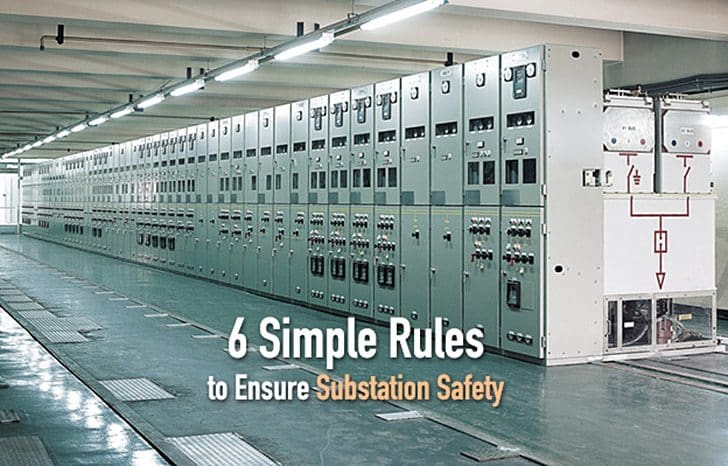Importance of safety protection
Another extremely important substation engineering aspect is associated with safety protection. It is fair to say that safety is always a No. 1 priority in substation design, operation and maintenance.

Unlike the case where a higher reliability required a larger investment, we can’t put a price tag on safety since there is no such thing like working conditions being more or less safe. It should always be 100% safe to work at or visit the substation.
There are numerous laws, rules, codes, etc. governing safety requirements; of the most important being “IEEE Standard C2-2012. 2012 National Electrical Safety Code®” (NESC®)
Safety standards contain requirements for:
- Enclosure of electrical equipment
- Rooms and spaces
- Illumination
- Floors, floor openings, passageways, stairs
- Exits
- Installation of equipment:
- Protective grounding
- Guarding live parts
- Working space above electrical equipment
- Specific rules for installation of all typical substation equipment
All these measures are based on common sense and the goal to provide a safe environment for substation personnel.
6 rules to provide substation safety
Rule no. 1 (clearance)
Enough clearance from energized parts should be provided to avoid accidental contact with them. If that can’t be met, live parts should be guarded or enclosed.
Rule no. 2 (minimum height)
A minimum height from the ground to any ungrounded part of an electrical installation should be 8’-6”, so a person staying on the ground can’t touch a substation element or its part which may become energized accidentally. For example, the bottom of a post insulator supporting an energized bus does not normally have any potential.
Rule no. 3 (illumination…)
There should be sufficient illumination for personnel to clearly see their surroundings and perform any work safely. Required illumination levels are specified in NESC® [1].
Rule no. 4 (passageways…)
All passageways and stairs should be wide enough for personnel to navigate them safely, adequate railing should be provided, and floor openings should have guard rails.
Rule no. 5 (evacuation routes)
Exits should be clearly marked and evacuation routes should be free from obstructions. Depending on the function of the building (for example, control house), it may require several exits to avoid personnel being trapped during equipment fault, fire, etc.
Rule no. 6 (grounding, as always)
All substation metallic structures, fences, and equipment tanks should be connected to a station ground grid which should be designed to ensure that step and touch potential values are lower than the ones stipulated in the applicable standards.
Reference: Fundamentals of Modern Electrical Substations; Part 3: Electrical Substation Engineering Aspects by Boris Shvartsberg, Ph.D., P.E., P.M.P.











Edvard, you made a lot of great points on how to ensure safety during substation construction and other projects. It makes a lot of sense to have a sufficient amount of illumination so that surroundings are clear to see. I think that it would be very smart to hire oversight and consulting services to promote further safety at your substation.
how much distance required for 11 kv and 430 V from panel area.Any literature on it.
I noticed one person sitting and working inside the substation.
Is it safe? If not what are the guidelines/recommendations and hazards governing the same.
Proper Practice and Use of Electrical Technical Terminology [Jargon]:
1.) Substation not Sub Station or Sub-Station
2.) Switchyard not Switch Yard or Switch-Yard
3.) Luminaire not Luminaries
4.) Panelboard not Panel Board
5.) Switchboard not Switch Board
6.) Switchgear not Switch Gear
7.) Lightning Protection not Lighting Protection
8.) Busway not Bus Way
9.) Busduct not Bus Duct or Bus Duck
10.) Raceway not Race Way
11.) Underground not Under Ground
12.) Underfloor not Under Floor
13.) Wireless not Wire Less
12.) Shutdown not Shut Down
14.) etc…
What level of competency is required for a person to enter a sub station to reset the power switch
Its great that you are publishing
Some of that is like refreshing our knowledge
Hello,
is there international standards define the safety distance between the electrical substation and residential areas?
if there any recommendation to not use a wooden desk or chair inside the the medium voltage substation ??
You are providing knowledge with minimum. Words
emergency push button to switch off pwer is also important
who do I get in touch with concerning an electricity sub station that is causing us difficulty in using our right of way as the neighbour parks his cars in front of its gates,I did mention that I thought that the front of the sub station had to be kept clear, the owner of the rented property tells me that he was given permission by the people who were at the sub station at the time, this was a couple of years ago and getting to our right of way is worst as there are often two or three cars in front of the sub station. please help.
A very useful page. Thanks
IEC61482-1 covers the Box-Test standard for testing arc flash clothing materials when carrying out maintenance work on power substations – please see http://www.cablejoints.co.uk/blog/article/iec61482-1-arc-flash-box-test-standard
Most importantly Arc Flash Calculations shall be done and safe distances shall be marked. NFPA 70 E makes it very clear and IEEE Std 1584-2002 (Guide for Performing Arc-Flash Hazard Calculations). In India Client does not worry much of Arc Flash Studies.
Very useful information…thanks
Great Site for updating self knowledge